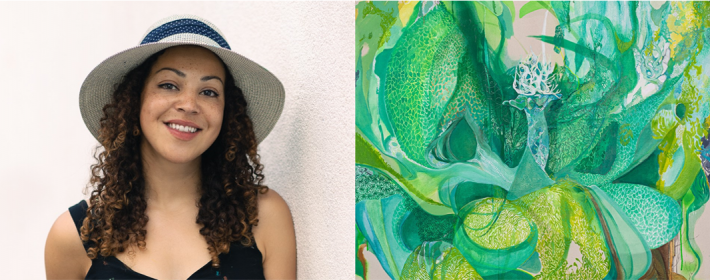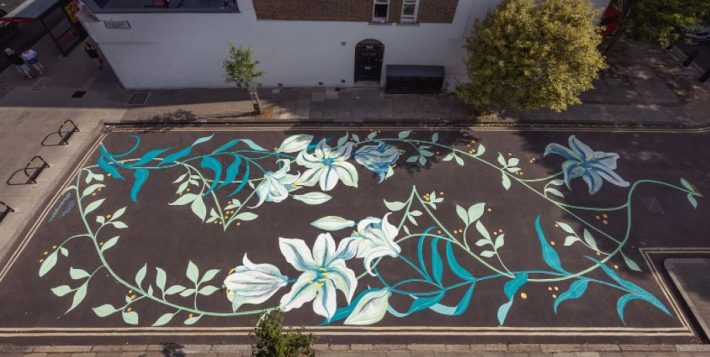Metamorphosis study in oil
Created by Bryony Benge-Abbott, “Metamorphosis study in oil” was inspired by conversations with many of the contributors working on other artworks in this exhibition, focusing on our role as a society in making green visions a reality. Find out more about how a connection and empathy with nature may be essential to our battle against the climate crisis:

Bryony Benge-Abbott
Website | LinkedIn | Twitter | Instagram
Job: Visual artist and creative producer
Location: South East England
Bio: Bryony Benge-Abbott is a visual artist and producer creating installations, interventions and experiences to invite a deeper exploration of the natural world and our relationship with it. Her visual art practice spans oil paintings, wild drawing walks and street art and is particularly focused on concepts of place and of ecological interconnectedness. As public engagement consultant and creative producer, Bryony supports academics, health care providers, government, cultural venues, community organisations and charities to design and deliver public realm science engagement projects.
Q: We loved the more abstract style of this piece, what questions or concepts did you want to convey through this piece?
A: When it came to creating this painting I wanted to focus in on this question of how we can become more closely attuned with nature. What personal journey of change might urban-dwellers embark on so as to be able to fully support city-wide adaptations in light of the climate crisis? The resulting painting-study is an early expression of what emerged for me from this research as some of the key stages of transformation involved in strengthening our emotional relationship with nature. Abstract figures move throughout a landscape of moss, lichen and roots, where boundaries are blurred and the botanical world and the human world are integrated with moments of delighting, listening and becoming. I consider ‘Metamorphosis study in oil’ to be a starting point to an ongoing study into the different potential dimensions and experiences of nature connectedness. It offers to the BES exhibition a broader view on what adopting a more eco-centric way of being human might feel like, as a precursor to accepting and championing changes to our cities in the face of climate change.
Q: You ended up working with a number of ecologists on this piece, how did you go about incorporating the different discussions and points of view into the artwork?
A: Being able to speak to different ecologists and social scientists through this project gave me a fascinating insight into the number of stakeholders and stages involved in getting any initiative off the ground, particularly now that a myriad cultural and social values are being considered alongside the previous ‘ecosystem services’ model in order to inform policy decisions. Sensitivity to the different needs, uses, perceptions and experiences of landscape was a common theme in our discussions. Collaboration and inclusion were two other words I heard frequently, with everyone I spoke to highlighting the need to spend the time genuinely listening to what the community needs in their local area so as to avoid parachuting in with nature based ‘solutions’ that actually become problems, exasperate existing tensions or fall into the trap of green-gentrification. I really valued this detail and breadth of opinions as it gave me the opportunity to ground some of the concepts I have been exploring in my recent work with the real-world experiences of those working on the ground to implement some of the BES policies.
Current work:
- From the 22nd July, I will be the artist in residence for London’s Orlean House Gallery, where I will be spending a couple of months sharing my wild drawing practice as I investigate how we can renew our connection with the natural world.
- For the exhibition-keen, I am also featured in the Orlean House Gallery’s ‘Remember the Future’ exhibition which runs until 14th Nov and interrogates our connection with our local habitats and ecosystems.
- For a real-life example of people transforming their local greenspaces, I recently finished a mural on Caledonian Road as part of the installation of a new ‘pocket park’ in London’s Freeling Street. After painting 20m of recently pedestrianised road with an arts and crafts inspired mural, Islington Play Association are installing community planters and adding trees and cycle hoops.

Contributors to the artwork
Bryony’s artwork was inspired by conversations with many of the contributors working on other artworks in this exhibition: Abi Gardner (Nature Scot), Bethany Chamberlain (British Ecological Society), Chris R J Pollard (Forest Research, BES Scottish Policy Group), Christian Dunn (Bangor University), Donya Davidson (the Scottish Wildlife Trust and The City of Edinburgh Council).
Future Green Spaces Virtual Exhibition
You can check out the final masterpiece and all the other brilliant artworks via our virtual gallery overlooking Edinburgh’s iconic Arthur’s Seat, You can the exhibition and all other BES online events (from an ecology-themed comedy night and draw-alongs to insect decline debates) on the BES Edinburgh Science Festival event hub here.
Like what we stand for?
Support our mission and help develop the next generation of ecologists by donating to the British Ecological Society.